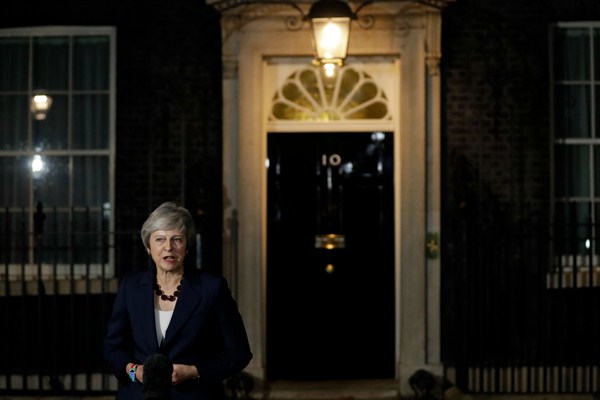For British Prime Minister Theresa May, each hurdle cleared on the road to Brexit only seems to make the going tougher. During an emergency meeting on Wednesday, May’s Cabinet approved a draft agreement on Britain’s withdrawal from the European Union, a day after May announced that she had reached a draft deal with European negotiators. But she’s not out of the woods yet. The deal must still be approved by the British Parliament, as well as by the European Council of EU heads of state and the European Parliament.
For May, whose political future hangs in the balance, the greatest dangers appear to be at home rather than in Brussels. Her Brexit negotiating strategy has been disavowed by Conservative Party hard-liners. The Democratic Unionist Party of Northern Ireland, upon which her minority government depends in Parliament, has expressed its disapproval of the deal’s approach to the Irish border. And the opposition Labour Party has signaled it is likely to vote against the deal.
If approved, the current deal locks in a lengthy transition period during which the U.K.’s trade terms with the EU will remain unchanged pending further negotiations. If it is rejected, Britain will leave the EU on March 29, 2019, with no deal in place at all, raising the prospect of a chaotic and destabilizing rupture. This collection of five recent WPR articles provides comprehensive analysis of why negotiating Brexit has been so difficult and what’s at stake.
Why Negotiating Brexit Is So Hard
Kimberly Ann Elliott | Sept. 11, 2018
A little more than two years since a bare majority of British voters opted to leave the European Union, and just over six months before it happens, negotiators are still trying to determine what the post-Brexit relationship will look like. As of March 29, 2019, the United Kingdom will no longer be part of the EU, and while the parties have agreed on a 21-month transition period, time is running out. The U.K. needs to find a way to maintain free trade in goods and services with what is by far its largest trading partner, in order to avoid large disruptions to the British economy. But that will be no easy task because the issues are complex, and the politics fiendish.
Goodbye to All That? Brexit and the Future of the United Kingdom
Andrew Whitworth and Matthias Matthijs | April 4, 2017
After clearing all the legal and political obstacles with surprising ease, British Prime Minister Theresa May filed the papers for the United Kingdom’s divorce from the European Union in Brussels in March 2017. In political terms, there is no way back for the U.K., now that it has pulled the trigger on Article 50 of the EU’s Lisbon Treaty, formalizing its departure from the bloc. But the U.K. finds itself only at the end of the beginning of the long and arduous road toward Brexit. And while the focus for the next two years will be on the British-European relationship and the EU’s internal cohesion, Brexit has also set in motion a series of centrifugal forces within the United Kingdom itself.
As the Reality of Brexit Sinks In, There Are No Good Options for the U.K.
Matthias Matthijs | July 12, 2017
What a difference a few months can make in British politics. In early May, a confident Prime Minister Theresa May looked well on her way to securing a much bigger majority for her Conservative Party in the House of Commons on a platform of “strong and steady leadership” and a promise to deliver on Brexit. Jeremy Corbyn’s Labour Party looked out of touch with the real concerns of most British people and seemed destined for electoral oblivion. So the shock result of a hung parliament after the U.K. general election on June 8 not only transformed the British political landscape, it also cast a dark cloud of uncertainty over the shape that the country’s exit from the European Union would take.
Because of Brexit, Northern Ireland’s Peace Deal Faces Its Toughest Test
Graham Walker | Nov. 28, 2017
The deadlocked political situation in Northern Ireland shows no sign of ending, at least this side of Christmas. The region’s two main parties—the conservative Democratic Unionist Party, or DUP, and left-wing, nationalist Sinn Fein—still cannot reach an agreement to restore a devolved power-sharing government, which was brought down by a domestic scandal in January. The crisis has been deepened considerably by the prospects of a British exit from the European Union that calls into question the spirit of the Good Friday Agreement of 1998 that ended three decades of violence between nationalists and unionists. That deal, which has been the basis of the uneasy peace that has held in this divided society ever since, now faces its toughest test to date.
Britain’s Torturous EU Exit and the Dilemmas of National Sovereignty
Stewart M. Patrick and Terrence Mullan | Sept. 18, 2018
More than two years after narrowly approving a referendum to leave the European Union, the British are discovering that asserting national sovereignty is less straightforward than the proponents of Brexit promised. Leaders of the “Leave” campaign in 2016 painted the issue in black and white. Britain had subordinated its sovereignty to Brussels, not least its authority to control its own borders. A fully independent Britain would regain those rights, while also negotiating a favorable, bespoke trade agreement with the EU’s remaining 27 members. With only seven months left before the deadline to leave the EU, it is clear that this scenario was a fantasy. Britain is experiencing the trade-offs inherent in modern national sovereignty.

